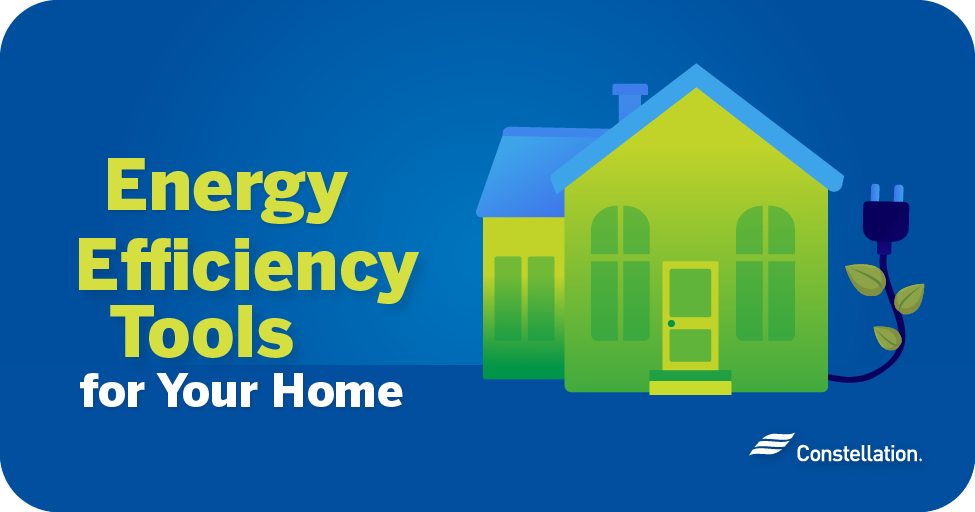Energy efficiency tools help you contribute to a healthier climate, enhance air quality for you and your family, improve comfort and save you money. Thinking twice and doing what you can to conserve energy is a good start. These energy-saving tools will help you be even more effective.
- Measuring energy efficiency
- Energy efficiency tools to help you save energy at home
- More tips for improving your home’s efficiency
How do you measure energy efficiency?
How energy-efficient is your home? What areas can be improved? How much savings will you get from the possible investments you might make? You cannot truly know the answers to these questions unless you measure your home’s overall energy efficiency and how well specific areas perform. Thankfully, measuring is easy with the various energy efficiency tools and resources available today.
5 energy efficiency tools to help you save energy at home
Tracking your energy use, benchmarking how you compare to the average, then making effective changes that save energy in your home can help you lower your bills, improve comfort and health, and help the environment. Here are five tools to help you do just that.
1. Determine which appliances are using the most energy
Do you know which appliances in your home are using the most energy? The answer might surprise you. You can perform your own usage audit by checking the energy requirements of each of your devices and appliances, then using that data to estimate their energy use.
In the summer, you might find it worthwhile to figure out how much it costs to run an air conditioner. If you can automate home appliances that use the most electricity, you take the guesswork out and don’t have the burden of trying to manually optimize your usage.
2. Calculate and compare your total home energy usage
We have calculated the average home power usage to make it easy for you to benchmark your own usage. In addition to our energy estimating resource, the government offers a tool for estimating appliance and home electronics energy use with a handy calculator.
The ENERGY STAR® yardstick also makes it easy to compare your home’s annual energy use to similar homes by size, location, family make-up and the fuels and systems you use.
3. Find the most energy-efficient appliances and electronics
When it’s time to replace old appliances or if you find a particular device that is simply using too much power, you’ve got a number of tools to find energy-efficient appliances and electronics. Do you know what features contribute to making appliances energy efficient? Our appliances guide is a helpful resource for educating yourself before you start shopping.
The ENERGY STAR® product finder is a great place to begin your search. You can also look for energy-efficient products on Energy.gov. More companies are building in automation to make it easier to optimize how you are using energy with smart kitchen gadgets.
4. Get customized energy saving recommendations
The government’s Home Energy Saver™ is one of the more effective online energy efficiency tools for helping you think through your specific systems to make them more efficient. You begin by describing your home in detail. The tool’s algorithm then suggests changes you can make that are appropriate for your family, home, location and local energy prices.
5. Locate tax rebates and incentives for energy efficiency
Programs that encourage you to make your home more energy efficient are plentiful. That said, no list of energy saving tools would be complete without including ways to help you find all rebates and incentives available to you.
The Database of State Incentives for Renewables & Efficiency® will help you find options in your state. We also offer a homeowners guide to tax credits and rebates. If you are working from home, check out our resources for your home office or home-based business. You can save money as you save energy.
More tips for improving your home’s energy efficiency
Here are more energy-saving strategies you can use in any location and during any season.
Home energy efficiency tips for winter
Heating your home is likely your largest energy expense in winter. Insulate, update and maintain, while taking note of these winter home improvement energy efficiency tips.
Energy-saving tips for spring
In this season of renewal, take the time to change filters, perform regular maintenance on all systems, check your air conditioner, and consider some upgrades. Spring energy saving tips include performing an energy audit to figure out where you can get the most improvements. Investing in smart devices is one way to enjoy savings. As you do your spring planting, explore these smart devices for automating your garden.
Improving home efficiency in the summer
Managing heat and water are the major challenges of saving energy in the summer. The goal is to use as little energy as possible to stay cool and to make careful use of water to keep your garden green. Explore ways to make your air conditioner more efficient and to minimize its use. When and how you cook, control of sunlight entering your home, and how you water your plants all will affect your comfort and energy usage.
Tips for improving efficiency in the fall
Fall is the best time to get your air conditioner ready to sit idle through the cold months and get your heating system ready for the coming cold weather. Fall energy saving tips for your home are all about thinking ahead and being prepared. Performing maintenance now and upgrading insulation can prevent expensive problems in cold months.
Save money year-round with Constellation
No matter what the season, using energy efficiency tools can help you improve the health and comfort of your home, while cutting costs and lowering your carbon footprint. Whether it is providing energy-saving tools, protecting your air conditioner from breakdowns or finding the best rates and plans among your home energy options, Constellation is your partner in making the best possible use of our energy resources.
